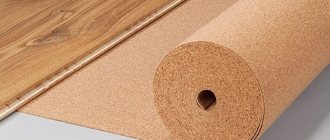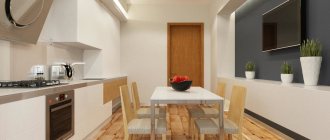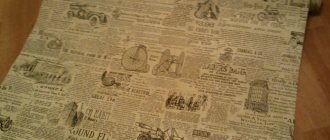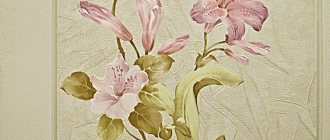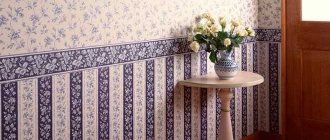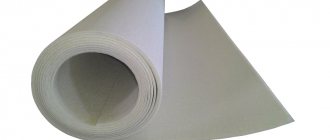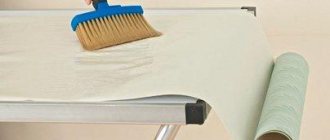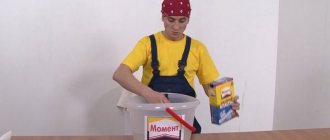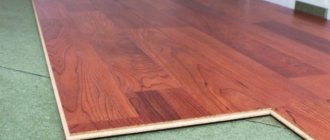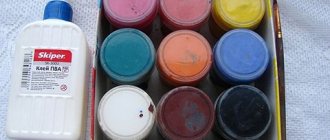Cork wallpaper? beautiful and environmentally friendly material. They give the room a cozy and respectable look, but are expensive. But if you replace the wallpaper with a cork backing, you can fit within a small budget, and the result will be no worse.
The underlay is a mandatory component in the construction of a floor covering laid in a floating manner. The use of technical cork in this role makes it possible to partially level out base defects, as well as provide sound and heat insulation. But home craftsmen have long paid attention to another advantage of the cork substrate? its attractive appearance, and began to be used for decorative decoration of premises.
It is convenient to buy cork backing in Moscow in the Dominar online store. We offer technical cork of the Portuguese brand Granorte with a thickness from 2 mm to 10 mm in rolls.
Wall decoration with cork: cork backing on the wall instead of wallpaper
Cork wallpaper is a beautiful and environmentally friendly material. They give the room a cozy and respectable look, but are expensive. But if you replace the wallpaper with a cork backing, you can fit within a small budget, and the result will be no worse.
The underlay is a mandatory component in the construction of a floor covering laid in a floating manner. The use of technical cork in this role makes it possible to partially level out base defects, as well as provide sound and heat insulation. But home craftsmen have long paid attention to another advantage of cork substrate - its attractive appearance, and began to use it for decorative finishing of premises.
Is it possible to put cork on the walls?
The material successfully imitates cork wallpaper and is advantageous to use for decorative wall decoration for economic reasons. But it was created for other purposes, so it’s natural to ask the question: is the technical characteristics of a cork backing suitable for a wall instead of wallpaper?
The coating has the following properties:
- environmentally friendly and safe (90% consists of natural recycled products and does not contain chemicals harmful to human health);
- good soundproofing and thermal insulation characteristics;
- high compression ratio;
- moisture resistance;
- fire resistance (without the release of toxic gases);
- absence of static electricity.
Cork is a durable material that retains its attractive appearance for many years. The elastic structure of the coating allows it to successfully withstand mechanical stress.
Having analyzed the performance qualities of cork substrate, we see that it is suitable for decorative purposes and is a good choice for wall cladding in both residential and public spaces.
How to glue cork backing to the wall?
It is possible to reliably and efficiently fix the cork covering only with the help of a properly selected adhesive composition.
Henkel has developed a special composition - contact adhesive Moment Cork. The preparation is quick-setting and has a high initial bonding force, therefore it is suitable for installing the coating on both horizontal and vertical surfaces. It can be used to fix floor and wall cork coverings: sheet and roll substrates, as well as cork moldings.
We offer to buy Moment Cork glue 1 liter and 5 liters at an attractive price on our website.
The composition fits perfectly on metal, plastic, rubber, leather, wood and even felt substrates. After drying, it forms an adhesive joint that is resistant to moisture, low temperatures, as well as weak acids and alkalis. Suitable for use not only indoors, but also on a glazed balcony.
Glue Moment Cork is non-toxic and does not contain toxic solvents.
DIY wall decoration with cork backing
The substrate is supplied in rolls, so it should be cut into panels of the required length. The cut pieces are laid out on a flat surface. Place some kind of weight on top to prevent the material from twisting.
Attention! It is not recommended to use a 2 mm thick substrate for wall finishing. Sheets of this thickness are not strong enough and may tear during installation.
Decorating walls with cork begins with careful preparation of the surface. The base is leveled, cleaned of dirt and strengthened with a primer.
Then they mark the wall, determining in what order the cork will be laid on the glue. Masking tape is placed next to the marking lines. This technique will make it easy to get rid of excess glue protruding from under the sheets.
How to glue cork to a wall
For finishing work, use a spatula with fine teeth. The glue is applied directly to the base, trying to distribute it as thoroughly and evenly as possible and not go beyond the boundaries of the masking tape.
Since the working time of cork glue is only 10-20 minutes, an area the size of one sheet is covered with the composition at a time.
To finish external and internal corners, the cork backing is cut into strips 30 mm wide. The length depends on the height of the trim. The strips are fixed using masking tape. For gluing external corners, a ready-made cork corner is also used.
Installing a cork on a wall is no different from gluing wallpaper. The sheets are applied to the surface treated with glue, pressed and smoothed, squeezing out all the air and smoothing out lumps of glue. For this purpose, you can use a special rubber roller, which is used to process wallpaper joints, or a large-diameter construction roller with short pile. If there are no tools, then it is enough to press on the surface of the coating with a dry, clean cloth.
Then remove the masking tape while pressing the cork backing sheet against the wall. Excess glue is cleaned off with a spatula or sharp knife. Any composition that has not hardened can be removed with a damp sponge.
The coating must dry within 24 hours. After this period, the surface can be varnished. The varnish is applied with a wide brush in two layers.
Decorating walls with cork is an excellent choice for those who want to get a beautiful and expensive interior for an affordable amount.
Source: https://Dominar.ru/probkovaya-podlozhka-na-stenu-chem-i-kak-kleit/
Flaws
There were also a few drawbacks:
- Despite its elasticity and stability, prolonged exposure to heavy objects can cause the substrate to deform.
- The price is an order of magnitude higher compared to analogues.
- Cork is able to block outgoing noise, but at the same time it allows incoming sounds to pass through.
Cork backing for walls is a practical and durable material. Cork does not tend to change its characteristics throughout its service life. It protects the surface from condensation and fungus, and also perfectly levels the base, heat and sound insulates the room.
Cork backing for walls, video
Wall decoration with cork backing
Cork is obtained from the bark of a certain type of oak tree. Trees of this type grow mainly in Africa. Since ancient times, cork has been used in various spheres of human activity. The building materials industry produces a material called cork backing.
The main purpose of the underlay is to serve as a lining under floor covering structures (laminate, parquet, linoleum, carpet and vinyl). However, people have long noticed that a cork backing glued to a wall can perfectly serve as wallpaper.
Why are cork coatings attractive?
Cork flooring has many advantages
Cork is a natural material that naturally fits into the human world around us. This is a clean, environmentally friendly product.
Qualities such as soundproofing, very low thermal conductivity, and aesthetic appearance are crucial in using cork backing on walls instead of wallpaper.
To convince the reader of this, we present a table of the quality characteristics of cork:
No. Technical characteristics of the plug Unit. measurementsIndicators
| 1 | Density | Kg/m2 | 220-250 |
| 2 | Thermal conductivity | W/m2 | 0,042 |
| 3 | Sound insulation coefficient | — | 0,85 |
| 4 | Sound absorption | Decibel | 12 |
| 5 | Humidity threshold | % | 7 |
| 6 | Tensile strength | Kg/cm2 | 2 |
| 7 | Chemical resistance | — | Inertia |
Why are we talking about cork backing when there are special cork wallpapers on sale. The thing is that wallpaper made from this material costs 3-4 times more than the backing.
Required tools and materials
As in any type of activity, before starting work, prepare and check the availability of the necessary tools and materials:
- pencil or felt-tip pen;
- metal ruler 2 m long;
- square;
- roulette;
- rags;
- fine-toothed spatula;
- solvent;
- masking tape;
- sharp construction knife;
- gloves;
- cork glue.
Preparatory work
Before proceeding directly to finishing the walls with cork, it is necessary to carry out a number of preparatory operations.
- The walls are checked for evenness. Dents and cracks are repaired with putty.
- All surfaces for pasting are treated with primer.
- The location of the substrate sections is marked on the walls.
- Since the backing rolls are 1 m wide, it is most convenient to cut the main sections of wallpaper 1.5 m long. That is, each main fragment of the coating will cover a wall area of 1.5 m2.
- When the number of main sections of the substrate is determined, then the sizes of additional fragments will be visible from the markings.
- If all the work is carried out in the same room where the pasting will be done, then to cut the rolls of backing, lay a sheet of fiberboard or other dense material on the floor.
- The rolls of the substrate are unrolled and laid on the floor. To give the material the appearance of a horizontal plane, large, heavy planes are laid on the cork. For example, a dining table is placed on unfolded rolls of wallpaper with the tabletop down. In general, the main goal is to withstand the plug under load for 12 hours, or even better - a day.
- Then they proceed directly to cutting the substrate. This is done using a metal ruler, a square and a knife.
Pasting walls with cork backing
The work of gluing cork to walls consists of several stages:
- Open the container with ready-to-use glue. The glue is thoroughly mixed until a homogeneous mass is obtained. This can be done with any clean rod.
- Apply a layer of glue to the wall using a notched trowel. The viscous mass is leveled with a spatula so that the thickness of the glue is about 1.5 mm.
- Pasting begins from one of the upper corners of the wall.
- Apply masking tape along the perimeter of the marking of the first section of wallpaper. This is done so that when leveling the cork on the wall, excess glue does not stain the adjacent surfaces.
- A piece of wallpaper is glued to the fenced area.
- After this, they proceed to covering the adjacent section of the wall with glue. At the junction of two sections, remove the masking tape.
- When joining adjacent sheets of cork, the released glue is immediately removed with a rag.
- It is advisable that the vertical seams of adjacent rows of wallpaper sections be made staggered.
- After the main large fragments have been glued, they proceed to gluing small finishing sections of the substrate. To learn how to properly stick a cork on a wall, watch this video:
Glue for cork on walls - types, brands, how to glue
Cork panels are produced in the form of wallpaper with or without paper backing, as well as in the form of slabs. Wallpaper that does not have a base is fragile to break and is not durable in general. Therefore, you should not work with such materials yourself; it is better to entrust this to specialists. To glue paper-based canvases and slabs on your own, it is important to choose the appropriate wall adhesive for cork.
Original ideas for crafts made from plastic bottle caps.
Fridge magnets.
Nowadays, in every home you can find at least one magnet on the refrigerator, and sometimes you may not even see the refrigerator itself due to the huge number of magnets. Therefore, such a magnet made from caps will undoubtedly be an excellent craft. It is done very easily.
Let's take caps, small magnets, markers, glue. It is necessary to immediately treat the surface of the caps with a solvent or a special degreaser. Place a magnet on the inside of the lid with glue. On the reverse side, using felt-tip pens, we draw some kind of face or whatever our imagination suggests. For the face, you can even glue on toy eyes with beads for a more lively look. From these magnets you can make bunches of berries or two cherries, fastening them together with green thread or green wire. You can also add a bow to your magnet.
Tips and tricks for working with cork
There are wallpapers that are additionally protected by applying wax; dirty fingerprints remain very visible on them. To clean them, you can warm up the area with a hair dryer.
They try to ensure that the adhesive does not get on the tiles because it will be impossible to remove it, such material will be damaged.
The use of acrylic composition requires fixing the material to the wall immediately after application. The contact adhesive should soak into the surface within 15 minutes.
They try not to get any adhesive on the tiles because it will be impossible to remove.
Cork coating looks impressive and has many technical advantages. Installation is simple and you can do it yourself. As a result, you can get a strong and durable coating. You can purchase it in any city: Gomel, Moscow, Kazan, Rostov and others.
Today my channel is thriving
Today the channel is almost 2 years old, 450 videos have been uploaded on it, and the income is already measured in much more than a few hundred dollars.
About 70% of the audience are women. The vast majority of them are 24 years of age or older. Moreover, it is important that the promotion of the channel to the “burzhunet” has yielded quite significant results. There are a lot of viewers from English and Spanish speaking countries. America alone generates as much profit as the entire RuNet. And the “Western” audience is much more expensive for advertising than the Russian-speaking audience. Unfortunately, this is so, these are the realities of life.
All my flower “disgrace” turned out to be interesting to 100,000 subscribers, including decorators, mothers on maternity leave, pensioners, children and just creative people. For many of them, growing floristry has become a small home business.
I'm proud to say that we have the largest flower channel on YouTube. I tried to collect the most current master classes on making floristry from paper, fabric, isolon, foamiran and EVA.
Oh yes, an important fact is the availability of the material. I clearly understand that at the beginning of the journey it is difficult for a master to snatch 5-10,000 rubles from the family budget to participate in a paid master class, so I share the information with everyone completely free of charge. I am sincerely happy about the successes of my students; I enjoy looking at photos from weddings decorated with life-size flowers, photo sessions and shop windows.
Photo background
Today's craze for photography makes it urgent to create an original photo background for bright pictures. Photo studios are interested in this. Bloggers readily use photophones. Craftswomen also prefer to have a good background when photographing their own works, which sell better thanks to this.
To create a photo backdrop, the remains of the floor laminate are just suitable. You can combine materials of different textures and get an individual background that will highlight the advantages of what is in the foreground in the photo.
Design of window or door slopes
What interesting things can you make from leftover laminate flooring with your own hands? If large format planks are available, you can use them when lining window and door openings. Laminate slopes look quite attractive and go well with other wood-look elements in the interior.
You can also use this material for finishing arched elements and window sills. Here, laminate cladding will allow you to create a complete design solution. If you just want to slightly update the interior, you can decorate the door with the remaining slats, and not just the elements framing it. This laminate coating is fixed with liquid nails.
